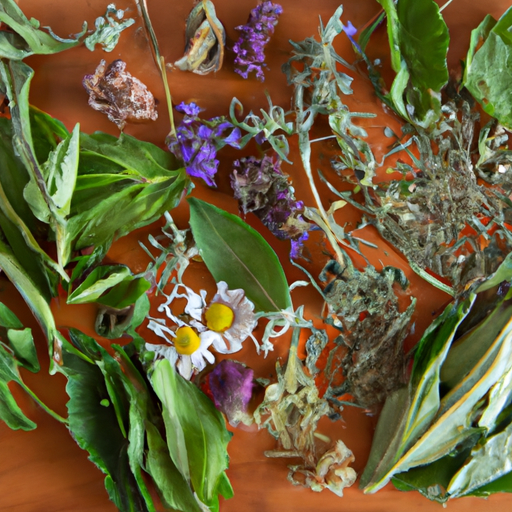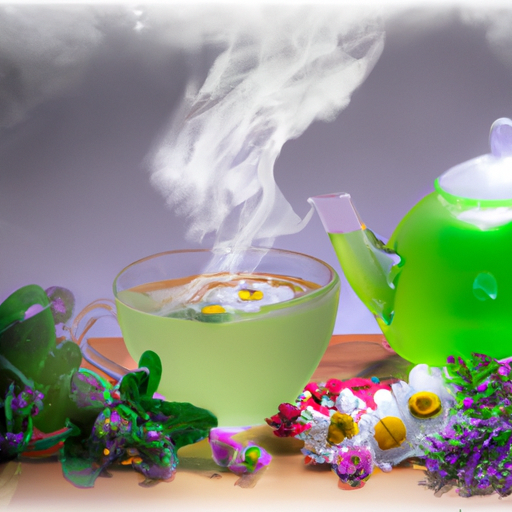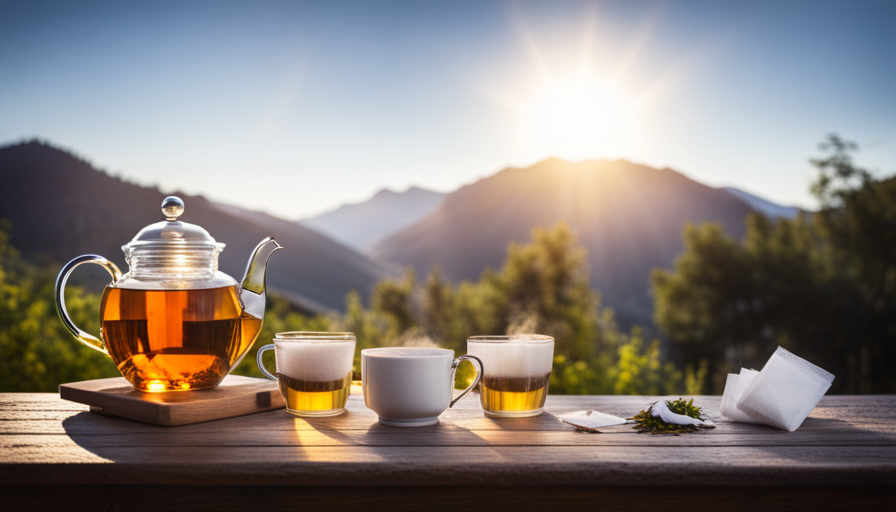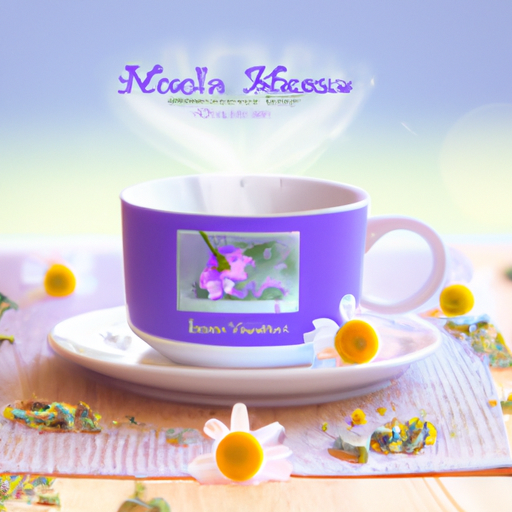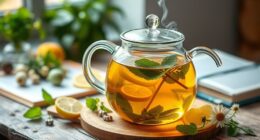I do you know that non-herbal tea is the second most popular drink in the world after water? Indeed, tea is beloved by many people worldwide.
But what exactly is non-herbal tea? In this article, I will delve into the fascinating world of non-herbal tea, exploring its various types, flavor profiles, brewing techniques, and health benefits.
Non-herbal tea is derived from the leaves of the Camellia sinensis plant, which undergo a process of withering, rolling, oxidation, and drying. Unlike herbal teas, which are made from a variety of plants and fruits, non-herbal teas come in a wide range of flavors and aromas that can satisfy even the most discerning palate.
So, whether you’re a tea aficionado or simply looking to explore new beverage options, join me on this journey to discover the wonders of non-herbal tea.
Key Takeaways
- Non-herbal tea is derived from the leaves of the Camellia sinensis plant.
- There are different types of non-herbal tea, including black, green, white, oolong, and pu-erh tea, each with its own unique flavor profile and health benefits.
- Brewing techniques for non-herbal tea require specific temperatures and steeping times to achieve the best flavor.
- Non-herbal tea has cultural significance and symbolizes hospitality, respect, and mindfulness.
What is Non-Herbal Tea?
So, you’re probably wondering, what exactly is non-herbal tea? Well, let me break it down for you. Non-herbal tea is any tea that isn’t made from herbs or botanicals, but rather from the leaves of the Camellia sinensis plant.
Unlike herbal teas, which are often made from a variety of plants and flowers, non-herbal tea is solely derived from the leaves of this specific plant. The Camellia sinensis plant is grown in various regions around the world, and depending on the processing methods, different types of tea are produced.
Non-herbal teas, such as black, green, white, and oolong tea, all come from this same plant and offer unique flavors and health benefits.
Now, let’s delve into the different types of non-herbal tea.
Types of Non-Herbal Tea
When it comes to non-herbal tea, there are several types that are worth exploring. Black tea, known for its strong and robust flavor, is a popular choice among tea enthusiasts.
Green tea, on the other hand, is known for its more delicate and grassy taste.
White tea, with its subtle and light flavor, is often considered the most delicate of all teas.
Oolong tea, with its unique combination of characteristics from both black and green tea, offers a rich and complex taste.
Lastly, Pu-erh tea, aged and fermented, is known for its earthy and bold flavor.
Black Tea
Indulge in the rich and robust flavor of black tea, a beverage that’ll truly awaken your senses.
Black tea is a type of non-herbal tea that’s made from the leaves of the Camellia sinensis plant. It undergoes a process called oxidation, which gives it its distinct flavor and dark color.
Besides its delicious taste, black tea also offers numerous health benefits. It’s known to improve heart health, boost metabolism, and enhance mental alertness.
When it comes to choosing the best black tea brands, some popular options include Darjeeling, Assam, and Earl Grey. These brands are known for their high-quality leaves and exceptional taste.
Now, let’s move on to the next section where we explore the wonders of green tea.
Green Tea
Renowned for its refreshing taste and numerous health benefits, green tea, made from the leaves of the Camellia sinensis plant, offers a vibrant and invigorating experience. Green tea comes in a variety of flavors, ranging from grassy and vegetal to floral and fruity. Some popular flavors include jasmine, lemon, and matcha.
Not only does green tea taste delicious, but it also provides incredible health benefits. It’s rich in antioxidants, which help protect the body against free radicals and reduce the risk of chronic diseases. Additionally, green tea contains compounds that can boost metabolism, aid in weight loss, and improve brain function.
Transitioning into the subsequent section about white tea, it’s important to note that both green and white tea come from the same plant, but they differ in their processing methods.
White Tea
Immerse yourself in the delicate and subtle flavors of white tea as it gently unfurls its fragrant and ethereal essence. White tea is renowned for its numerous health benefits. It’s packed with antioxidants, helping to boost the immune system, reduce the risk of chronic diseases, and promote overall well-being.
The production of white tea is a meticulous process. The tea leaves are harvested at a young age, then carefully withered and dried. This minimal processing allows the tea to retain its natural purity and subtle flavor profile. Unlike other teas, white tea undergoes minimal oxidation, resulting in a pale, almost colorless infusion. Its light and refreshing taste make it a perfect choice for those seeking a soothing and rejuvenating tea experience.
Now, let’s delve into the world of oolong tea and discover its distinct characteristics.
Oolong Tea
Let’s embark on a flavorful journey as we explore the unique characteristics of oolong tea, a delightful brew that dances on the taste buds like a graceful ballerina, blending the richness of black tea with the freshness of green tea.
Oolong tea offers a range of benefits, from promoting weight loss to reducing the risk of heart disease. With its semi-oxidized leaves, oolong tea possesses a distinct flavor profile that varies depending on the degree of oxidation. It can be floral and fruity with hints of honey, or earthy and toasty with a touch of nuttiness. The flavors are as diverse as the regions where oolong tea is cultivated, including China, Taiwan, and India.
Transitioning to our next exploration, let’s discover the intriguing world of pu-erh tea.
Pu-erh Tea
Pu-erh tea, with its bold and unique flavor, has captured the attention of tea enthusiasts around the world. Made from fermented leaves of the Camellia sinensis plant, this Chinese tea is known for its rich, earthy taste and smooth finish.
But beyond its delicious flavor, pu-erh tea also offers a range of health benefits. It’s believed to aid in digestion, promote weight loss, and lower cholesterol levels. Additionally, it contains antioxidants that help protect against cell damage and boost the immune system. The fermentation process of pu-erh tea creates beneficial bacteria, which can improve gut health and digestion.
These health benefits, combined with its distinct taste, make pu-erh tea a popular choice among tea lovers.
Moving on to the flavor profiles of non-herbal tea…
Flavor Profiles of Non-Herbal Tea
Indulge in the rich and aromatic flavor profiles of non-herbal tea, transporting your taste buds to a world of delicate notes and vibrant complexities.
Here are four types of non-herbal tea that offer unique flavors and numerous health benefits:
-
Black Tea: With its bold and robust flavor, black tea is known for its malty undertones and hints of caramel. It’s rich in antioxidants and can boost heart health.
-
Green Tea: This tea has a fresh and grassy taste, with a hint of sweetness. Green tea is packed with catechins, which can enhance metabolism and aid in weight loss.
-
White Tea: Delicate and subtle, white tea has a light floral taste. It’s high in antioxidants and may help in reducing the risk of chronic diseases.
-
Oolong Tea: Oolong tea falls between black and green tea in terms of flavor and oxidation level. It offers a smooth and fruity taste, along with potential benefits like improving brain function and digestion.
Now, let’s explore the brewing techniques for non-herbal tea.
Brewing Techniques for Non-Herbal Tea
Discover the art of brewing your favorite non-herbal tea with these simple techniques that’ll elevate your tea experience to new heights.
The key to a perfect cup lies in the brewing temperature and steeping time. Different types of non-herbal tea require specific temperatures to bring out their optimal flavors. For example, green tea should be brewed at around 175°F to 185°F, while black tea benefits from a higher temperature of 200°F to 212°F.
Steeping time also plays a crucial role in achieving the desired taste. Green tea should be steeped for 1 to 3 minutes, while black tea requires 3 to 5 minutes. By following these guidelines, you can unlock the full potential of your non-herbal tea and savor its rich flavors.
Transitioning into the next section, it’s important to note that brewing techniques not only enhance taste but also contribute to the health benefits of non-herbal tea.
Health Benefits of Non-Herbal Tea
Improve your overall well-being by incorporating the health benefits of these flavorful and aromatic non-herbal teas into your daily routine. Non-herbal teas, such as green tea, black tea, oolong tea, white tea, and pu-erh tea, offer a multitude of health benefits.
| Tea Type | Health Benefits |
|---|---|
| Green tea | Rich in antioxidants, boosts metabolism, aids in weight loss |
| Black tea | Supports heart health, improves digestion, enhances mental alertness |
| Oolong tea | Regulates blood sugar levels, promotes healthy skin, aids in digestion |
| White tea | Boosts immune system, reduces inflammation, supports oral health |
| Pu-erh tea | Reduces cholesterol levels, aids in digestion, promotes weight loss |
These teas can be brewed using various techniques to maximize their health benefits. Whether you prefer steeping them in hot water, cold brewing, or using a tea infuser, the brewing process allows the leaves to release their beneficial compounds.
Transitioning to the subsequent section about popular non-herbal tea blends and recipes, explore the exciting world of tea flavors and discover delightful combinations to elevate your tea-drinking experience.
Popular Non-Herbal Tea Blends and Recipes
I’m excited to discuss some popular non-herbal tea blends and recipes. One classic blend that I enjoy is Earl Grey Tea, which combines black tea with a hint of bergamot oil for a unique and aromatic flavor.
Another favorite of mine is Jasmine Green Tea, which combines the delicate floral notes of jasmine flowers with the refreshing taste of green tea.
If you’re in the mood for something creamy and comforting, a Matcha Latte made with powdered green tea and steamed milk is the perfect choice.
Finally, for a spicier and more exotic option, Chai Tea blends black tea with a variety of spices like cinnamon, cardamom, and ginger for a warm and invigorating beverage.
Earl Grey Tea
Try a cup of Earl Grey tea for a unique and aromatic twist on your tea-drinking experience. Earl Grey tea is a popular non-herbal tea blend that is infused with the essence of bergamot, a citrus fruit. This infusion gives Earl Grey tea its distinct and refreshing flavor. In addition to its delicious taste, Earl Grey tea also offers several health benefits. It is known to improve digestion, boost the immune system, and promote mental alertness. To make Earl Grey tea, simply steep a tea bag or loose tea leaves in hot water for about 3-5 minutes. You can also enhance the flavor by adding a slice of lemon or a touch of honey. Now, let’s move on to the next section about jasmine green tea, which is another delightful non-herbal tea option.
Jasmine Green Tea
Indulge in the aromatic delight of jasmine green tea, where the delicate blossoms infuse your cup with a floral symphony of flavors. This exquisite tea not only offers a delightful taste but also provides numerous health benefits.
Jasmine tea is known for its calming properties, helping to reduce stress and anxiety. It’s also rich in antioxidants, which can boost your immune system and protect against chronic diseases.
To make jasmine tea, simply steep green tea leaves with jasmine blossoms in hot water for a few minutes, allowing the flavors to meld together. Serve it hot or chilled for a refreshing beverage any time of the day.
Now, let’s explore the next section and dive into the world of matcha latte.
Matcha Latte
Embrace the creamy richness of a matcha latte as its vibrant green hue and velvety texture whisk you away to a moment of pure tranquility. Matcha, a finely ground powder made from shade-grown green tea leaves, is at the heart of this delightful beverage. To create a matcha latte, simply combine the powdered tea with steamed milk and a touch of sweetness, such as honey or agave syrup.
Not only does this drink offer a unique and soothing flavor, but it also boasts numerous health benefits. Matcha is rich in antioxidants, vitamins, and minerals and has been linked to improved focus, enhanced metabolism, and a strengthened immune system.
As we transition into the world of chai tea, let’s explore the bold and aromatic flavors that await us.
Chai Tea
Discover the comforting warmth and exotic allure of chai tea, a fragrant blend of spices that dance together in a symphony of flavors, transporting you to a bustling spice market. Chai tea originated in India and has gained popularity worldwide for its unique taste and numerous health benefits.
Traditional chai recipes typically include a combination of black tea, milk, and a blend of spices such as cardamom, cinnamon, ginger, cloves, and black pepper. The black tea provides a rich and robust flavor while the spices add depth and complexity.
Chai tea is not only delicious but also offers several health benefits, including improved digestion, boosted immunity, and reduced inflammation.
To fully enjoy the experience of non-herbal tea like chai, it’s important to use high-quality ingredients and brew it with care. So, let’s move on to the next section and explore some tips for savoring your cup of non-herbal tea.
Tips for Enjoying Non-Herbal Tea
When it comes to enjoying non-herbal tea, there are a few key points to keep in mind.
First, I always make sure to pair my tea with the right food, as certain flavors can complement each other beautifully.
Second, proper storage and freshness are essential for preserving the quality of the tea, so I store mine in airtight containers away from light and moisture.
Lastly, I take the time to truly taste and appreciate my tea, paying attention to its aroma, flavor profile, and overall experience.
Pairing Tea with Food
To enhance your dining experience, try pairing non-herbal tea with complementary flavors of food.
When it comes to pairing tea with desserts, the possibilities are endless. The richness of a black tea can be perfectly complemented by the sweetness of a chocolate cake, while a delicate green tea can enhance the flavors of a light fruit tart.
In some tea ceremonies and traditions, specific teas are paired with certain foods to create a harmonious balance of flavors. Experimenting with different tea and food combinations can be a fun and satisfying experience that will elevate your meal to a whole new level.
So, next time you sit down for a meal, consider the flavors of your food and choose a non-herbal tea that will complement and enhance them.
Now, let’s move on to the next section about proper storage and freshness.
Proper Storage and Freshness
Properly storing your tea is essential to ensure its freshness and flavor remain intact, so make sure to keep it in an airtight container to prevent any unwanted moisture or aroma from seeping in. This will help maintain its quality and prolong its shelf life. Additionally, store your tea away from direct sunlight and strong odors, as they can affect the taste and aroma. To give you a visual representation of the impact of proper storage techniques on tea freshness, take a look at the table below:
| Storage Method | Freshness Rating |
|---|---|
| Airtight Container | High |
| Exposure to Air | Low |
| Sunlight Exposure | Low |
By following these proper storage techniques, you can ensure that your tea remains fresh and flavorful. Now let’s move on to the next section about tea tasting and appreciation.
Tea Tasting and Appreciation
You’ll truly enjoy the experience of tasting and appreciating tea, allowing you to discover the subtle nuances and flavors that make each cup unique and satisfying. Tea tasting isn’t just about drinking a beverage; it’s a way to connect with the rich cultural significance of tea.
Here are four key aspects to consider when delving into the world of tea appreciation:
-
Tea Ceremonies: Engaging in traditional tea ceremonies can deepen your understanding of the history and rituals associated with tea consumption.
-
Cultural Significance: Tea holds great importance in various cultures, symbolizing hospitality, respect, and mindfulness. Exploring the cultural significance of tea can enhance your appreciation for this ancient beverage.
-
Aroma and Taste: Paying attention to the aroma and taste of the tea allows you to unravel its complexities and identify different flavors, such as floral, earthy, or fruity notes.
-
Brewing Techniques: Learning proper brewing techniques, including water temperature and steeping time, can enhance the flavors and ensure a perfect cup of tea every time.
Embrace the world of tea tasting and let it transport you to a realm of sensory delights and cultural appreciation.
Frequently Asked Questions
Can non-herbal tea be consumed by people with dietary restrictions?
Yes, non-herbal tea can be consumed by people with dietary restrictions. However, it’s important to check the ingredients as some non-herbal teas may contain additives or allergens that could be restricted in certain diets.
Can non-herbal tea be consumed by pregnant or breastfeeding women?
Yes, pregnant or breastfeeding women can consume non-herbal tea. While it’s important to moderate caffeine intake, non-herbal teas like green or white tea can be enjoyed in moderation, providing hydration and potential health benefits.
Are there any potential side effects or risks associated with drinking non-herbal tea?
There can be potential side effects and risks associated with drinking non-herbal tea. It is important to be aware of caffeine content, potential for dehydration, and any individual sensitivities or allergies.
Can non-herbal tea be enjoyed hot and cold?
Yes, non-herbal tea can be enjoyed both hot and cold. It offers various health benefits, such as improved hydration, antioxidants, and potential metabolism boost. The temperature preference depends on personal taste and the weather.
How does the caffeine content of non-herbal tea compare to other caffeinated beverages?
Compared to other caffeinated beverages, non-herbal tea generally contains less caffeine than coffee. However, it still provides a boost of energy and focus. It’s a great alternative for those looking for a milder caffeine kick.
Conclusion
In conclusion, non-herbal tea is a wonderful beverage option for tea lovers looking for a variety of flavors and health benefits. With its wide range of types and flavor profiles, there’s a non-herbal tea to suit every taste preference. Whether you prefer a strong and robust black tea or a delicate and floral green tea, there’s something for everyone.
And while some may argue that non-herbal tea lacks the natural healing properties of herbal teas, it still offers numerous health benefits, such as antioxidants and hydration. So, don’t hesitate to explore the world of non-herbal teas and discover your new favorite blend!


